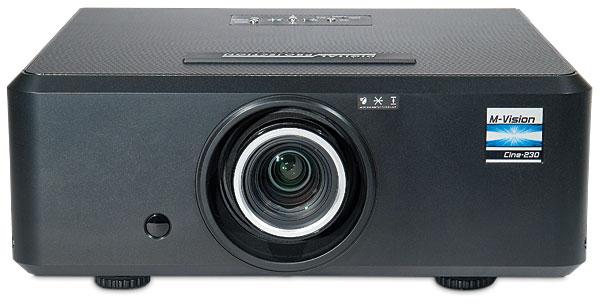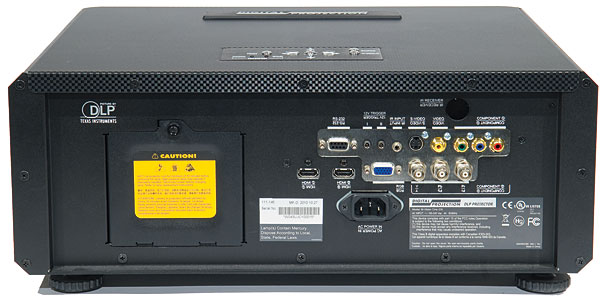Digital Projection M-Vision Cine 230-HC DLP Projector

A few months back, we reviewed the Digital Projection HighLite Cine 260-HC (Home Theater, May 2011). But like most three-chip DLP designs, its $30,000 price could buy a nicely equipped new car. Some day, perhaps, the prices of such projectors may come down to earth, but until then, most of us are left to other options.
Not that this is a bad thing. The best LCD and LCOS models can knock your socks off. Single-chip DLPs also have their passionate, barefooted advocates. If you’re one of them, Digital Projection has you covered. Their 2D, M-Vision Cine 230-HC may be the company’s lowest-cost home theater–ready design, but its performance is anything but bargain basement. It’s definitely worth a closer look.
Out and About
While the generic term DLP (Digital Light Processing—patented and licensed from Texas Instruments) is most commonly used when referring to the projection technology in this projector, the active heart of DLP is the DMD, or digital micromirror device. The DMD for a high-definition projector consists of millions of tiny oscillating mirrors, one for each pixel. A three-chip DLP projector employs three DMDs, one for each primary color (red, green, and blue). But a single-chip design such as this one produces colors via a rotating color-filter wheel with, at a minimum, red, green, and blue segments. Depending on the design, there may be multiples of these, and other colors as well.
The 230-HC is the same size as the 260-HC and shares its sibling’s pro-inspired, plain-Jane look. It comes with one of three lenses. Our sample was the longest-throw version: a 1.85to-2.40:1 zoom, which can produce a full-width image on a 100-inch-diagonal, 87-inch-wide 16:9 screen from a distance of approximately 161 to 209 inches (throw distance = screen width x lens throw ratio). A model with a shorter-throw, 1.56-to-1.86:1 range is also available ($7,495). There are also two optional converter lenses (0.8x and 1.25x, not tested here), which can lengthen or shorten the zoom ratios—a useful feature that, in our experience, is unique to the 230-HC.
The zoom, focus, and horizontal and vertical lens shift operations are all manual. The zoom ring on the lens is hard to turn without also moving the focus ring, so I’d recommend the following setup procedure: first, rough zoom and focus, then fine zoom, and finally fine focus. The shift function requires the removal of a trim panel at the top of the projector and turning the adjustments hidden beneath it with the included Allen wrenches. The trim panel comes off easily, and the adjustments feel solid, unlike some of the flimsier manual lens shift controls we’ve encountered.

The 230-HC doesn’t have the usual picture modes. But it does provide four different presets—memories into which you can program different setups for various applications and recall them as needed.
The main menu offers the usual picture controls, although with an HDMI input, both the saturation and hue controls are locked out. This is defensible in theory, since HDMI sources should be standardized and not require these adjustments. But in practice, most consumer HDTVs and projectors leave these controls active for HDMI. I didn’t miss them here, but they can sometimes be useful. In addition to the common aspect ratios, the 230-HC offers the vertical stretch mode (here called Theaterscope) that you’ll need when you use an anamorphic lens (not used in this review). An overscan control provides two active settings. The Crop setting blanks 3 percent from the left and right sides of the image; Zoom produces a 6-percent overscan all around. I left Overscan off.
A gamma control offers five options, but instead of them being listed by the usual gamma numbers, they’re labeled CRT, Film, Video, Punch, and Graphics. I used the Film setting almost exclusively. It averaged 2.24—varying from 2.17 at 20 IRE to 2.37 at 90 IRE, the latter near peak brightness. (A lower gamma brightens the image, and a higher gamma darkens it.) The CRT gamma setting measured around 2.5 overall, which was too dark and compromised shadow detail.
I left the color space in Auto, the color temperature at 6500K, and the color gamut in Rec. 709. The 6500K setting was reasonably accurate out of the box and a good start. The 230-HC’s RGB Adjust mode provides both high (gain) and low (offset) red, green, and blue controls to further fine-tune the gray scale. (This is a job for a trained calibrator with the appropriate test tools.)
The 230-HC has no color management system, which would provide the controls needed to reposition the individual color points and brightness levels. As delivered, the color points were very close to the Rec. 709 HD standard (see HT Labs Measures). But the brightness levels of the individual colors were a little too hot. Still, if the somewhat intense colors had any visible impact on the picture, it was unnoticeable.
There are no iris settings, either dynamic or manual. Some users might miss this feature. A well-designed dynamic iris could have improved the 230-HC’s so-so black level—though not everyone agrees that it’s a good idea. A manual iris can offer an effective way to finetune the peak brightness level.
According to Digital Projection, the 230-HC refreshes a 1080p/24 image at 48 hertz, with the additional frames required being repeats of the real frames (there are no frame-interpolation modes). This was a lower rate than usual for a projector (they typically refresh 24-Hz material at either 72 Hz or 96 Hz, and sometimes higher), but it produced no visible flicker. A 1080p/60 input (or an interlaced input that the projector first converts to 60p progressive) refreshes at 60 Hz.
The 230-HC provides 11 onboard test patterns, although my preference is to perform tests and calibrations from test discs on the primary Blu-ray player I plan to use for viewing Blu-rays and DVDs. In this case, that player was a Panasonic DMP-BDT350. The backlit remote can directly select between five of the seven video inputs. It can also directly select three of your four presets (the remote calls them User Memories) and call up eight of the most often-used picture controls.
So Big
Since I was concurrently evaluating a 101-inch-wide, 1.1-gain, 2.35:1 Elite screen, that’s the one I used for most of this review, only occasionally revisiting my 78-inch-wide, 1.3-gain Stewart StudioTek 130 (circa 2000—not a new 130 G3).
I watched mainly 2.35:1 sources to accommodate the Elite screen’s aspect ratio. But I didn’t use an anamorphic lens, as that would introduce an unwanted variable. Instead, I zoomed the image up until the picture fit the screen from left to right. The top and bottom black bars, an unavoidable distraction with such material on a 16:9 screen, fell beyond the borders of the 2.35:1 screen and became essentially invisible. I sat about 12 feet from the screen, a distance that produced a viewing angle from the 101-inch Elite of just under 39 degrees (the viewing angle is the angle of your forward vision filled by the screen). The projector lens was located 16 feet from the screen throughout the review.





























































